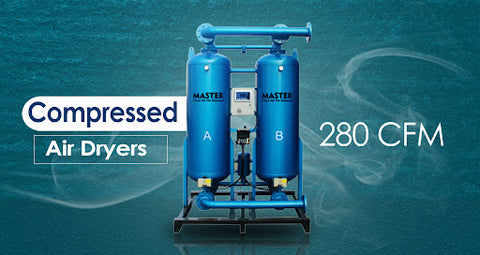Understanding 3 Common Types of Compressed Air Dryers
- William Cooper
- Sep 3, 2025
- 2 min read

Compressed air systems often contain moisture that can cause damage, corrosion, and inefficiency in equipment. Compressed air dryers play a crucial role in removing this moisture by lowering the dew point, ensuring dry air that prevents condensation in pipelines and machinery. There are various types of compressed air dryers designed to meet different industrial needs. Here we explore the three most common types: refrigerated air dryers, desiccant air dryers, and membrane air dryers.
Refrigerated Air Dryers
Refrigerated air dryers are the most widely used type of dryer. They function by cooling the compressed air to around 3°C (37-38°F), which causes the water vapor to condense into liquid water. This moisture is then separated and drained away, leaving dry, cooled air. The dried air is often reheated slightly to prevent condensation further downstream.
These dryers are reliable, simple to operate, and require relatively low maintenance. They are suitable for about 95% of industrial compressed air applications where a moderate dew point is acceptable. Refrigerated dryers can be either cycling or non-cycling. Cycling dryers adjust their cooling output depending on air demand, which saves energy, while non-cycling dryers run continuously for consistent dew points. Refrigerants like R-134a and R-410a are commonly used in modern units to facilitate cooling efficiently.
Desiccant Air Dryers
Desiccant air dryers remove moisture through adsorption using materials like activated alumina or silica gel, which have a high affinity for water. These dryers are capable of achieving extremely low dew points, as low as -40°C (-40°F) or even lower, making them ideal for applications that require very dry air.
There are primarily two types of desiccant dryers: heatless (non-regenerative) and heated (regenerative). Heatless dryers regenerate the desiccant by redirecting a portion of the dry air through the material, while heated dryers use external heat to drive off the moisture from the desiccant. Desiccant dryers are often used in industries with stringent moisture control needs, such as pharmaceuticals, electronics, and food processing.
Membrane Air Dryers
Membrane dryers offer a compact, chemical-free solution by separating moisture and contaminants through a semi-permeable membrane. The humid compressed air passes through hollow fibers inside the membrane, where water vapor diffuses out and is expelled, leaving dry air behind.
These dryers work best under higher operating pressures and are favored in applications requiring lightweight and space-saving solutions. Since membrane dryers do not use refrigeration or chemical adsorbents, they are environmentally friendly and require minimal maintenance. However, they may not achieve as low dew points as desiccant dryers.
Choosing the right compressed air dryer depends on the specific requirements for dew point, maintenance, energy efficiency, and application environment. Refrigerated dryers serve as a versatile and cost-effective solution for general use, desiccant dryers excel in ultra-dry air needs, and membrane dryers provide a compact, eco-friendly option.
Understanding these three common types empowers industries to optimize their compressed air systems, improve equipment lifespan, and maintain operational efficiency.







Comments